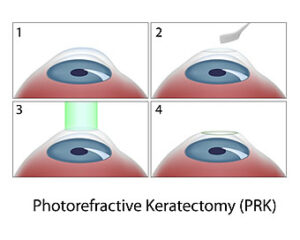When you think of vision correction procedures, the first one you probably think of is LASIK. LASIK is the most popular vision correction procedure, but it’s not the only one.
Another vision correction procedure available at New England Eye Center is PRK. Although LASIK is incredibly popular, PRK predates LASIK and was the first vision correction procedure.
It’s still performed today on many patients. PRK is a great vision correction option for many patients who have a refractive error and want to eliminate the need for glasses and contact lenses.
But how does PRK work, and how is it different from LASIK? And why is it worth considering over LASIK? Read on to find out!
What is PRK?

PRK stands for photorefractive keratectomy. Like LASIK, it’s a refractive eye surgery that uses a laser to correct refractive errors.
These include nearsightedness, farsightedness, and astigmatism. Correcting refractive errors requires changing the shape of the cornea, which is the transparent front part of your eye that light refracts through.
When you have a refractive error, it’s due to the irregular shape of your cornea. Refractive vision correction procedures correct the shape of the cornea by using a special laser called an excimer laser to remove cornea tissue as necessary for your specific error.
Both LASIK and PRK use an excimer laser to reshape the cornea. But before a surgeon can use the excimer laser, they must have access to the cornea.
A protective layer of tissue covers the cornea called the epithelium. LASIK bypasses this layer altogether by making a flap in the cornea with another kind of laser called a femtosecond laser.
After creating the flap, it’s lifted to provide access to the tissue underneath it. After getting the necessary access, the flap gets put back, acting as a natural bandage that protects the eye as it heals.
What Happens During PRK?

PRK, however, does not create a corneal flap. Instead, the epithelium itself gets removed using a chemical scrub.
Then the corneal tissue right underneath the epithelium is reshaped as necessary by your surgeon. Afterward, a bandage contact lens is placed over the eye to protect it as the epithelium regrows, which is a process that takes about two weeks.
LASIK is a newer procedure than PRK and has the benefit of showing immediate visual improvement. When you have PRK, it can take longer for patients to see visible improvement while the eyes heal.
However, the final results from LASIK and PRK are virtually identical, with most patients achieving 20/20 vision or better. Although LASIK is a more popular procedure and has its benefits, there are still reasons you may want to consider PRK:
1. Visual Freedom Without LASIK

LASIK is a procedure that plays off many of the ways that PRK works. After all, PRK was the original refractive laser eye procedure to receive FDA approval.
But one of the requirements of LASIK is that your cornea needs to be a certain thickness. To safely create a flap in the cornea, the cornea must be a certain thickness.
If the cornea is not thick enough, there may not be enough tissue left in the corneal bed. Thinner corneas should not undergo LASIK as it may lead to severe visual consequences and complications.
While most patients seeking LASIK have thick enough corneas, not all patients do. But if you find out you have thin corneas and otherwise qualify for a laser vision correction procedure, you can have PRK safely.
Because PRK has identical results to LASIK, it’s an excellent alternative for patients with thin corneas. Not being a LASIK candidate doesn’t have to mean the end of your vision correction dreams.
2. Easy on the Eyes

LASIK has advantages over PRK when it comes to recovery. You don’t see immediate visual improvement with PRK like with LASIK.
Initial recovery also takes a bit longer for PRK as the epithelium needs to regrow and regenerate. However, the difference in initial recovery time is only a matter of days.
Even with LASIK, it takes time for your vision to improve completely, even if you see some results immediately. Full recovery from LASIK and PRK takes 3-6 months when you’ll reach your peak vision.
The difference in initial recovery is only a few days, which is relatively minor if you’re hoping to correct your vision permanently. While it does take a little longer to heal after having PRK, it can also be less harsh on your eyes.
The corneal flap created during LASIK does ease the healing process, but the disturbance of so much corneal tissue has a higher probability of causing post-surgical dry eye. PRK patients, especially those predisposed to dry eye, experience fewer symptoms after having PRK than LASIK patients.
PRK may be the better option for a vision correction procedure for you if you struggle with dry eye. Getting LASIK may exacerbate your existing dry eye symptoms and make them worse.
3. Long-Lasting Results

Although PRK and recovery may differ slightly from LASIK and its recovery, the final results are the same. They’re also long-lasting.
PRK permanently changes your vision, so you don’t have to worry about the procedure ever “wearing off.” Remember that neither vision correction procedure will prevent age-related vision problems like presbyopia.
But they also won’t prevent receiving treatment for them either. You may still need reading glasses when you reach a certain age, but PRK lasts just as long as LASIK.
Like LASIK, the younger you are when you have PRK, the more years of incredible vision you can look forward to.
Are you ready to take the next step? Get started by scheduling your vision correction procedure consultation at New England Eye Center in Boston, MA, to determine which procedure is best for you!




